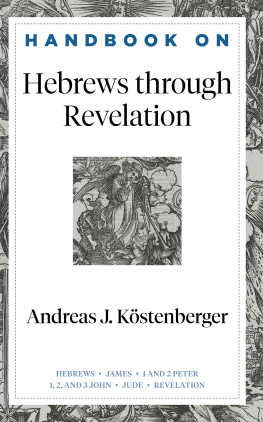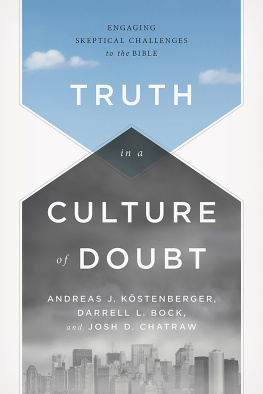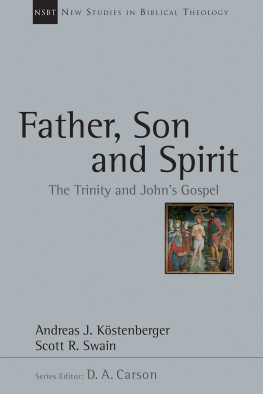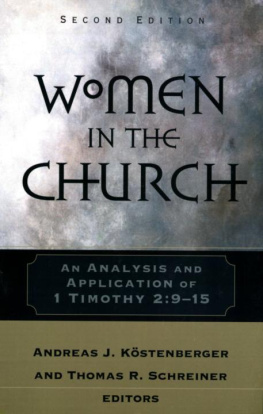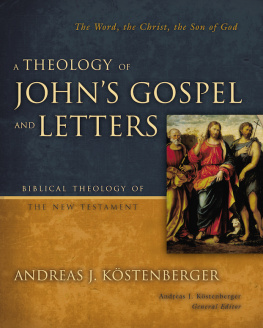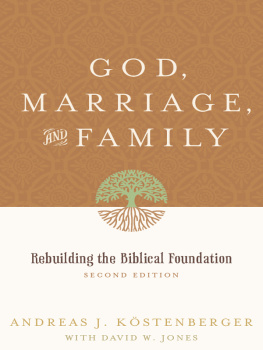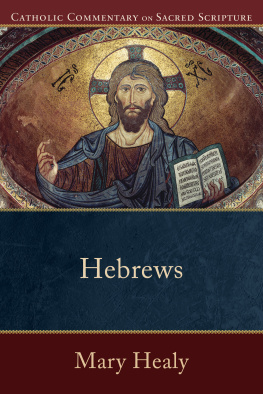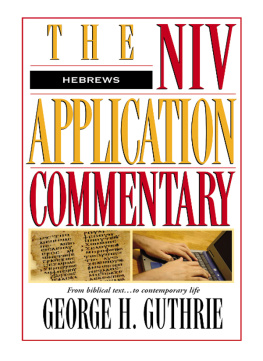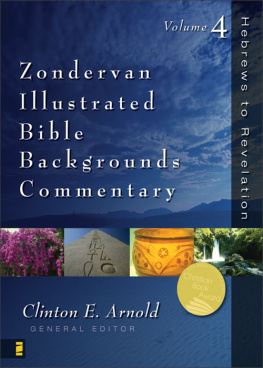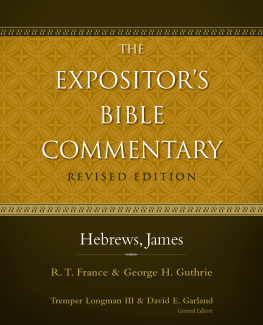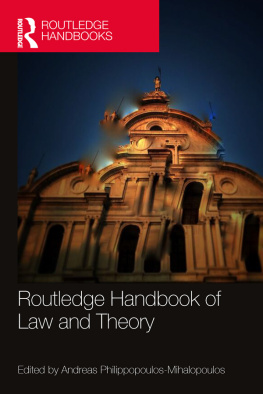Andreas J. Köstenberger - Handbook on Hebrews through Revelation
Here you can read online Andreas J. Köstenberger - Handbook on Hebrews through Revelation full text of the book (entire story) in english for free. Download pdf and epub, get meaning, cover and reviews about this ebook. year: 2020, publisher: Baker Publishing Group, genre: Religion. Description of the work, (preface) as well as reviews are available. Best literature library LitArk.com created for fans of good reading and offers a wide selection of genres:
Romance novel
Science fiction
Adventure
Detective
Science
History
Home and family
Prose
Art
Politics
Computer
Non-fiction
Religion
Business
Children
Humor
Choose a favorite category and find really read worthwhile books. Enjoy immersion in the world of imagination, feel the emotions of the characters or learn something new for yourself, make an fascinating discovery.
- Book:Handbook on Hebrews through Revelation
- Author:
- Publisher:Baker Publishing Group
- Genre:
- Year:2020
- Rating:4 / 5
- Favourites:Add to favourites
- Your mark:
- 80
- 1
- 2
- 3
- 4
- 5
Handbook on Hebrews through Revelation: summary, description and annotation
We offer to read an annotation, description, summary or preface (depends on what the author of the book "Handbook on Hebrews through Revelation" wrote himself). If you haven't found the necessary information about the book — write in the comments, we will try to find it.
Andreas J. Köstenberger: author's other books
Who wrote Handbook on Hebrews through Revelation? Find out the surname, the name of the author of the book and a list of all author's works by series.
Handbook on Hebrews through Revelation — read online for free the complete book (whole text) full work
Below is the text of the book, divided by pages. System saving the place of the last page read, allows you to conveniently read the book "Handbook on Hebrews through Revelation" online for free, without having to search again every time where you left off. Put a bookmark, and you can go to the page where you finished reading at any time.
Font size:
Interval:
Bookmark:
2020 by Andreas J. Kstenberger
Published by Baker Academic
a division of Baker Publishing Group
PO Box 6287, Grand Rapids, MI 49516-6287
www.bakeracademic.com
Ebook edition created 2020
All rights reserved. No part of this publication may be reproduced, stored in a retrieval system, or transmitted in any form or by any meansfor example, electronic, photocopy, recordingwithout the prior written permission of the publisher. The only exception is brief quotations in printed reviews.
Library of Congress Cataloging-in-Publication Data is on file at the Library of Congress, Washington, DC.
ISBN 978-1-4934-2363-7
Unless otherwise indicated, Scripture quotations are from The Holy Bible, English Standard Version (ESV), copyright 2001 by Crossway, a publishing ministry of Good News Publishers. Used by permission. All rights reserved. ESV Text Edition: 2016
Scripture quotations labeled KJV are from the King James Version of the Bible.
All italics in Bible quotations have been added by the author for emphasis.
To my students
past, present, and future
I have no greater joy than to hear
that my children are walking in the truth.
(3 John 4)
Cover
Half Title Page
Series Page
Title Page
Copyright Page
Dedication
Series Preface
Authors Preface
Abbreviations
1. Hebrews
2. James
3. 1 Peter
4. 2 Peter
5. 1 John
6. 2 and 3 John
7. Jude
8. Revelation
Scripture Index
Subject Index
Back Cover
The Handbooks on the New Testament are the counterpart to the well-received, four-volume set Handbooks on the Old Testament by Baker Academic. With the myriad of New Testament commentaries and introductions, why pen yet another series? The handbooks stand unique in that they are neither introductions nor commentaries. Most New Testament commentaries work in the trenches with verse-by-verse expositions, whereas introductions fly at forty thousand feet above the biblical text. This series lies between these two approaches. Each volume takes a snapshot of each New Testament passage without getting bogged down in detailed exegesis. The intent is for the reader to be able to turn to a particular New Testament passage in the handbook and quickly grasp the sense of the passage without having to read a considerable amount of the preceding and following discussion. This series is committed to summarizing the content of each major section of the New Testament. Introductory issues are not ignored (authorship, dating, audience, etc.), but they are not the focus. Footnotes, too, are used sparingly to keep the readers attuned to the passage. At the end of each chapter, the author includes a brief, up-to-date bibliography for further investigation.
Since the handbook focuses on the final form of the text, authors pay special attention to Old Testament allusions and quotations. The New Testament writers quote the Old Testament some 350 times and allude to it well over a thousand. Each author in this series notes how a good portion of those Old Testament allusions and quotations shape the passage under discussion. The primary audience of the handbook series is lay people, students, pastors, and professors of theology and biblical studies. We intend these volumes to find a home in the classroom and in personal study. To make the series more accessible, technical jargon is avoided. Each volume is theologically and pastorally informed. The authors apply their observations to contemporary issues within the church and to the Christian life. Above all, our prayer and desire is that this series would stimulate more study and serious reflection on Gods Word, resulting in godly living and the expansion of the kingdom.
Benjamin L. Gladd
Its been a wonderful challenge to comment succinctly on each of the so-called General Epistles and the book of Revelation. While the non-Pauline letters are often neglected, and Revelation has confounded many interpreters, these writings make an important contribution to the NT canon and merit careful study and application. While the placement of Revelation at the very end of the canon is not in question, the ancient manuscript tradition often places James, 12 Peter, 13 John, and Jude immediately following the book of Acts, which ties them more closely to the history of the early church, while Hebrews is often viewed as part of the Pauline corpus, whether the letter was written by Paul directlya minority opinion todayor one of his followers.
Placing the letters of James, Peter, John, and Jude in immediate proximity to Acts highlights the fact that each of these authors was an important figure in the early church. James was the leader of the Jerusalem church who presided over the so-called Jerusalem Council (Acts 15), which ruled on the delicate matter of criteria for gentile inclusion in the Christian community. Peter was the spokesman of the Twelve during Jesuss earthly ministry and was given the keys to the kingdom by Jesus (Matt. 16:19). He preached the first Christian sermon at Pentecost and presided over the inclusion of Jews and Samaritans into the early church (Acts 2:1441; 8:1425). Together with Paul, Peter is the leading character in the book of Acts and the main propagator of the message about the resurrected Jesus. John is the fourth evangelist and paired with Peter in both Johns Gospel and the book of Acts (John 13:2325; 18:1516; 20:210; 21:7, 1523; Acts 34; 8:1425). In his Gospel, he stakes the claim of having been closest to Jesus during his earthly ministry, even closer than Peter (John 13:23; cf. 1:18; 21:20). Intriguingly, these same three menJames, Peter, and John, in the same orderare identified by Paul in his letter to the Galatians as the pillars of the early church (Gal. 2:9).
Jude , finally, like James, was Jesuss half-brother, one of the four sons of Joseph and Mary (Matt. 13:55; Mark 6:3; also called Judas). While not included by Paul among the pillars, Jude was thus closely connected to both Jesus and James, the leader of the Jerusalem church, which not only tied him to the family of Jesus but also placed him in proximity to the apostolic circle. This family and apostolic connection made Jude, too, a suitable contributor to the NT canon. Hebrews , for its part, as mentioned, was often included alongside the other thirteen letters in the Pauline corpus, as it has been traditionally associated with the apostle Paul.
The book of Revelation brings closure to the biblical canon, providing a fitting bookend to the Scriptures by mirroring the opening book of Genesis. Together, these two books narrate Gods initial creation of the universe and humanity on the one hand and the new creation on the other. In between these two bookends, the Bible tells the story of humanitys fall, a series of covenants made between God and his people, first with the nation of Israel (Abraham, Moses, David), and climactically, in keeping with prophetic prediction, in and through Jesus the Messiah (the new covenant). In this way, Revelation brings the biblical story to a fitting conclusion and depicts the eternal bliss of the redeemed in the presence of their covenant-keeping God and of Jesus, the lamb of God and lion of Judah.
Writing this book would not have been possible without the support of my partner in life and ministry, Margaret, who has been an incredible blessing to me over the course of our thirty years of marriage (and counting!). Whenever Im asked to contribute to a useful project such as this, she wholeheartedly urges me to say yes. You are truly more precious than rubies, my love! In addition, Im grateful to the trustees of my institution, Midwestern Baptist Theological Seminary, and president Jason Allen for believing in me and for their generous support and encouragement. It means a lot. Im also grateful to Benjamin Gladd for his enthusiastic invitation to contribute this volume to the series, and to the publisher, Baker Academic, for its excellence in producing this work. Thanks also to Drake Isabell for his help with the Scripture index.
Font size:
Interval:
Bookmark:
Similar books «Handbook on Hebrews through Revelation»
Look at similar books to Handbook on Hebrews through Revelation. We have selected literature similar in name and meaning in the hope of providing readers with more options to find new, interesting, not yet read works.
Discussion, reviews of the book Handbook on Hebrews through Revelation and just readers' own opinions. Leave your comments, write what you think about the work, its meaning or the main characters. Specify what exactly you liked and what you didn't like, and why you think so.

